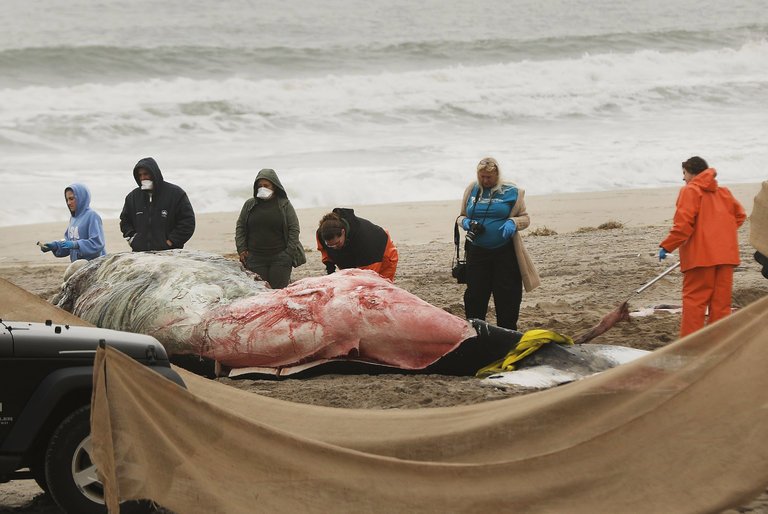Mass Die-Off of Whales in Atlantic Is Being Investigated
Humpback whales have been dying in extraordinary numbers along the Eastern Seaboard since the beginning of last year. Marine biologists have a term for it — an “unusual mortality event” — but they have no firm idea why it is happening.
Forty-one whales have died in the past 15 months along the Atlantic coast from North Carolina to Maine. In a news conference on Thursday, officials from the National Oceanic and Atmospheric Administration Fisheries said that they had not identified the underlying reason for the mass death, but that 10 of the whales are known to have been killed by collisions with ships.
The agency is starting a broad inquiry into the deaths.
These whales “have evidence of blunt force trauma, or large propeller cuts,” said Deborah Fauquier, a veterinary medical officer at the agency’s Office of Protected Resources. These collisions with ships were “acute events,” Dr. Fauquier said, and were being treated as the “proximate cause of death.”
Dr. Fauquier said that the number of whale strandings was “alarming,” and that she hoped the investigation might give a sense of what kind of threat this presents to this population of humpback whales and those around the world.
Advertisement
Continue reading the main story
On average, eight humpback whales are stranded each year from Maine to Virginia, and fewer than two are hit by ships, according to data from NOAA.
Continue reading the main story
An unusual mortality event is a specific designation under the Marine Mammal Protection Act, and is defined as “a stranding that is unexpected, involves a significant die-off of any marine mammal population, and demands immediate response.”
Whale or other marine mammal die-offs are often poorly understood by scientists, and this case is no exception. Officials from NOAA Fisheries could not explain why the animals were coming into greater contact with vessels, or if there were any human-caused or climate-related disturbances that had changed their behavior.
Gregory Silber, marine resources manager in the agency’s Office of Protected Resources, said that there had not been any increase in ship traffic in the region, and that the whales might be following their prey — they mostly eat krill and small fish — to areas where there could be more shipping.
Ten whales other than those killed by ships have been examined, but officials have not yet determined the cause of death. There is no indication that they were killed by disease.
Newsletter Sign Up
Continue reading the main story
Please verify you're not a robot by clicking the box.
Invalid email address. Please re-enter.
You must select a newsletter to subscribe to.
Sign Up You agree to receive occasional updates and special offers for The New York Times's products and services.
Thank you for subscribing.
An error has occurred. Please try again later.
You are already subscribed to this email.
View all New York Times newsletters.
- See Sample
- Manage Email Preferences
- Not you?
- Privacy Policy
- Opt out or contact us anytime
Humpback whales — which can be as long as 60 feet, weigh as much as 40 tons and can live for 50 years — are found in all of the world’s oceans. There are 14 distinct population segments — groups that follow certain migration and breeding patterns — of humpback whales, some of which are classified as endangered or threatened. The population along the Atlantic coast, which winters in the Caribbean and summers in the North Atlantic or Arctic regions, is not now considered threatened under the Endangered Species Act.
Around the world, there are an estimated 30,000 to 40,000 humpback whales, about a third of its original population. The Atlantic population is around 10,000.
Scientists have suggested that some whale deaths could be a result of marine noise, often a result of military activity, offshore drilling or exploration, which can disorient the animals and send them in the wrong direction, possibly toward beaches where they get stuck instead of into the deeper ocean. Mr. Silber, the NOAA manager, said he was not aware of a connection between ocean noise and these strandings.
A recent study has shown that dolphins, when escaping predators or the source of marine noise, might shoot up from a dive more quickly than they otherwise would, switching from slow, deliberate strokes to faster, longer ones, which can cause them to use double the energy they normally do, and exhaust them.
Advertisement
Continue reading the main story
The last major mass casualty event for marine mammals in this part of the world took place from 2013 to 2015, when a resurgence of the morbillivirus killed thousands of bottlenose dolphins on the Eastern Seaboard.
Among humpback whales, there was an unusual mortality event in 2006, following others in 2005, which involved other large whales, and 2003, which was primarily humpback whales. In each investigation, the cause was undetermined, officials said.
NOAA officials said members of the public looking to help could report stranded or dead floating whales to numbers listed on their website.
A version of this article appears in print on April 28, 2017, on Page A13 of the New York edition with the headline: Dozens of Dead Whales in Atlantic, and Scientists Aren’t Sure What’s Wrong. Order Reprints| Today's Paper|Subscribe
Continue reading the main storyRead the Original Article






























